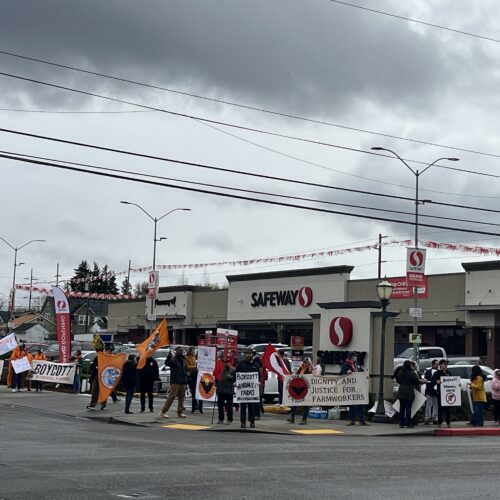
How Do Whales Respond To Noise Pollution? Drones May Tell Us
The whales off the West Coast depend on sound to communicate, navigate and find food. So, what happens to their health when we fill their habitat with noisy ship traffic?
Oregon State University researcher Dr. Leigh Torres is leading an ambitious new research project to find out, using drones and a variety of other tools to do health check-ups on the whales.
She and her research team are making regular trips to the ocean off the coast of Newport. The area is prime feeding ground for gray whales and also sees plenty of noisy ships and fishing vessels going in and out of Yaquina Bay.
“These gray whales here live in a really urban environment,” she said. “So, they’re constantly exposed to a lot of vessel traffic, mainly.”
Torres says it’s clear from underwater recordings that human noise can drown out whale calls, and research shows whales that live in noisier environments have higher stress levels.
“And we really we want to know if there are long-term consequences to their health and physiology,” Torres said. “So, is it stressing them out? And does that have long-term consequences?”
 An image captured by a drone of two gray whales off the coast of Newport under NOAA research permit #16111. Credit: Leigh Torres/Oregon State University.
An image captured by a drone of two gray whales off the coast of Newport under NOAA research permit #16111. Credit: Leigh Torres/Oregon State University.
New Research Territory
Finding the whales off the Oregon coast is the easy part of this research project. When the whales are migrating it’s not uncommon for Torres and her research team to see three whales at a time — surrounding the boat.
As soon as they see their first blow on the horizon, they drop a hydrophone that records all the underwater noise that the whales are hearing.
Then they snap pictures to figure out which whale they’re looking at, checking for unique markings so they can track each whale over time.
On one outing, they quickly identify one whale as “Scarback,” a mother whale with a calf and a huge, prominent scar.
But they can’t tell much about Scarback’s health by looking at her from the boat. That’s where the drone comes in.
By launching a drone, they go beyond what you can see from a boat and into new research territory. From above, they can measure how fat and healthy the whales are better than ever before. They can also get a clear view of its skin condition and sometimes what the whale happens to be eating when they fly overhead.
“We fly the drone over the animal to get information on length and girth — its body condition, essentially,” Torres said. “So we would expect that an animal that’s fat would have a lower stress level than an animal that’s skinny.”

Oregon State University researcher Leigh Torres photographs a gray whale off the coast of Newport. She’s studying the effects of noise pollution on whales in conjunction with the Cooperative Institute for Marine Resources Studies. Photo: Michael Bendixen/OPB
How Do You Know If A Whale Is Stressed Out?
How do you know if a whale is stressed out? It’s not easy. Torres has to watch the whale closely from a perch on the bow of the boat.
“Alright here we go,” she says. “Come on. Come on.”
Seeing nothing, she sighs.
“Nope,” she says. “Bugger!”
This goes on for quite some time. At one point, she gives a whale named “Blaze” a “ten minute warning.”
She’s waiting for the whale to release a gold mine of biological information that comes in the form of a reddish brown cloud in the water.
“So we’re just behind it,” she says. “Good positioning…Come on little buddy!”
Then she spots it and yells: “POOP!”
She dives for a net on a long pole and leans over the side of the inflatable orange wall of the Zodiac. She needs to move fast to scoop the poop before it sinks.
She plunges the net into the water, but when she brings it back up it looks empty.
“We got some,” she says, looking at her catch. “It was light. A light little poop.”
A few brown specks in the corners of the net aren’t much to look at, but even a tiny bit of poop contains hormones that tell her how much stress the whale is under. It also offers genetic information and confirms the sex of the whale.
“I’m never satisfied,” she says with laugh. “I always want more poop.”
 Oregon State University researcher Leigh Torres demonstrates how drone footage allows her to measure the length and girth of gray whales off the Oregon coast. Photo: Michael Bendixen/OPB
Oregon State University researcher Leigh Torres demonstrates how drone footage allows her to measure the length and girth of gray whales off the Oregon coast. Photo: Michael Bendixen/OPBConnecting The Dots
For Torres, the ultimate goal is to use the photos, drone videos and poop samples to build ongoing medical records for each individual whale. She keeps files and even a sort of whale Facebook to help her identify which whale is which and how fat and healthy they are.
“So, we’re able to identify individuals over and over again,” she said. “Once we can link all of our information, we can look for changes in body condition as well as maybe changes in stress or reproductive hormone levels.”
Eventually, with more and more research trips, she hopes to be able to tell whether whales living with more human noise are skinnier, having fewer babies or showing more signs of stress than whales in quieter areas.
“There have been studies showing humans that live in noisy environments are more prone to higher rates of cancer and disease,” she said. “And studies have shown animals that live closer to highways have higher stress levels.”
Researchers have long suspected that our noise pollution could threaten whale survival, but the closest they’ve come to proving it was in the days after 9/11 when shipping traffic was shut down. Researchers collected whale poop samples during the shutdown and found that their stress levels plummeted to levels they hadn’t seen before.
“The stress levels dropped far below what they thought was the baseline,” Torres said. “Then they went back up when shipping traffic resumed. That was our first jaw-dropping moment where we realized that noise is impacting the physiology of those whales.”
Oregon has plenty of gray whales, but other species around the world are on the brink of extinction.
Over the next few years, Torres hopes her research will break new ground on the question of whether whale survival depends on us turning down the volume on underwater noise.
“Ocean noise around the world is on the rise — mainly from shipping traffic,” she said. “These are big, long-lived animals that are trying to make a living — survive — within the ocean habitat that we keep venturing into more and more. It’s important that we make sure they’re doing that without too much impact from us.”
Copyright 2018 Earthfix/OPB
Related Stories:

Washington state reports 7-year peak in influenza-related deaths
The Washington state Department of Health reported on March 20th that influenza activity reached its highest levels in seven years, with the most flu-related deaths since the 2017-2018 flu season.

Searching for sage grouse: Looking for a chicken-sized needle in south-central WA
Seth Hulett, Audubon Washington’s senior program manager of the Columbia Plateau, searches through his spotting scope for sage grouse. (Credit: Courtney Flatt / NWPB) Listen (Runtime 4:12) Read In south-central

Landfill neighbors worry about PFAs contamination seeping into drinking water
A view of the landfill from Carole Degrave’s property line. (Credit: Courtney Flatt / NWPB) Listen (Runtime 0:54) Read For years, some people who live near a Central Washington landfill















